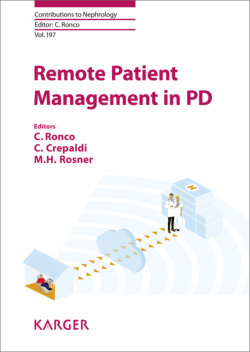Читать книгу Remote Patient Management in Peritoneal Dialysis - Группа авторов - Страница 12
На сайте Литреса книга снята с продажи.
PD Solutions
ОглавлениеIt was recognized early on that to remove uremic solutes effectively, a hypertonic solution will need to be instilled in the peritoneal cavity. The early PD solutions led to adverse events like post instillation pain (due to lack of acetate/lactate resulting in low Ph), hyperchloremic metabolic acidosis, volume overload, and hypertension [7], were mainly related to higher concentration of sodium in these solutions (Na and Cl concentration of 136 mEq/L). Subsequent formulations of PDS were appropriately modified in an effort to make them more physiological as well as to promote sodium removal by diffusion (sodium 130–135 mEq/L, chloride 99–100 mEq/L). Heusser [3] recognized that dextrose could be utilized as an osmotic agent to achieve ultrafiltration in the PDS. Although many other agents (e.g., glycerol, amino acids etc.) have since been tried, dextrose continues to be the preferred osmotic agent in the PDS. However, prolonged exposure to dextrose is associated with several unwanted effects that include hyperglycemia and new onset diabetes mellitus, weight gain, and dyslipidemia [8]. Also, prolonged exposure to dextrose can adversely affect the peritoneal membrane causing mesothelial toxicity, neo-angiogenesis, and formation of advanced glycosylation end products leading to loss of ultrafiltration and other adverse sequalae [9].
Table 1. Advantages of biocompatible solutions
PDS contain lactate as the buffer. The use of lactate (pH 5.5) buffered PDS has been implicated with in-flow pain. The stimulation of the polyol pathway by lactate may enhance glucose-related mesothelial cell toxicity [9]. PDS are heat-sterilized prior to use. Heat sterilization results in the production of glucose degradation products that are cytotoxic to the peritoneal membrane. The need for more biocompatible PDS (with lower proinflammatory profile and lower propensity to cause changes in peritoneal structure, function, and defense mechanisms) thus became increasingly apparent.
Since their introduction, biocompatible PDS have been widely used in Europe but they have not been available in the US with the exception of Icodextrin (7.5%), which was introduced in the 1990s. The 1.1% amino acid solution, lactate and lactate/bicarbonate buffered solution are some of the other biocompatible PDS [9] (Table 1).
Longer PD vintage predisposes to structural and functional changes of the peritoneal membrane resulting in ultrafiltration failure and reduced solute clearance, ultimately resulting in technique failure. The recognition of transforming growth factor β1 as a target molecule to reduce peritoneal fibrosis has led to the use of agents like aminoguanidine, pyridoxamine, pentoxyphilline, diltiazem, and dipyridamole. In this context, the reported utility of renin-angiotensin aldosterone blockers in the prevention of peritoneal fibrosis is noteworthy [9, 10].
